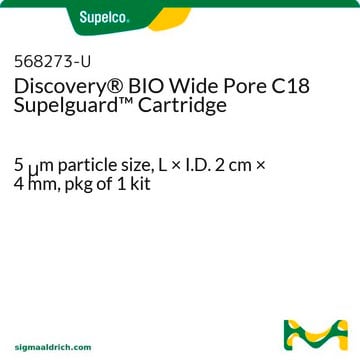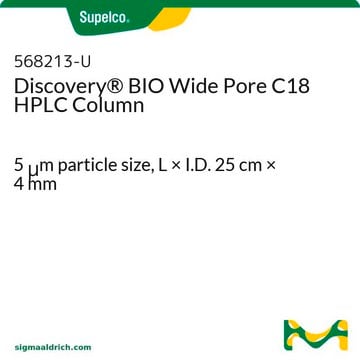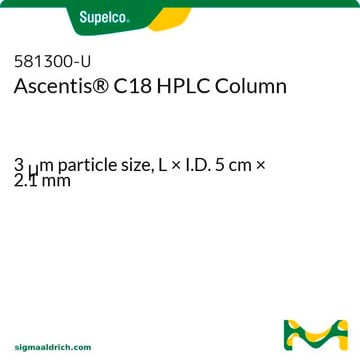Reverse Phase Column Rehydration Method:
1. The column should ideally not contain any buffer. If it does, thoroughly flush the column with water to remove the buffer.
2. Flush the column with 100% acetonitrile, starting at a flow rate of 0.3-0.5 ml/minute. Slowly increase the flow rate to 1 ml/minute, flushing for approximately 30 minutes, as long as the pressure does not excessively increase.
3. Equilibrate the column with the mobile phase specified on the Certificate of Analysis (CofA) of the column, and run a test mix similar to what was used to test the column.
4. If the performance is unsatisfactory, repeat the method, increasing the flushing with acetonitrile for one hour.
5. Repeat the test. If the performance is still not as expected, the column may have degraded.
568223-U
Discovery® BIO Wide Pore C18 (5 µm) HPLC Columns
L × I.D. 25 cm × 4.6 mm
Synonyme(s) :
Wide Pore C18 HPLC Column
About This Item
Produits recommandés
Nom du produit
Colonne HPLC Discovery® BIO C18 à larges pores, 5 μm particle size, L × I.D. 25 cm × 4.6 mm
Matériaux
stainless steel column
Niveau de qualité
Agence
suitable for USP L1
Gamme de produits
Discovery®
Caractéristiques
endcapped
Fabricant/nom de marque
Discovery®
Conditionnement
1 ea of
Ampleur du marquage
9.2% Carbon loading
Paramètres
0-70 °C temperature
400 bar pressure (5801 psi)
Technique(s)
HPLC: suitable
LC/MS: suitable
L × D.I.
25 cm × 4.6 mm
Superficie
100 m2/g
Couverture de surface
3.6 μmol/m2
Matrice
silica particle platform
fully porous particle
Groupe de la matrice active
C18 (octadecyl) phase
Taille des particules
5 μm
Dimension de pores
300 Å
pH de fonctionnement
2-8
Technique de séparation
reversed phase
Vous recherchez des produits similaires ? Visite Guide de comparaison des produits
Description générale
plus, la possibilité d′analyser des peptides sans ajout de TFA dans la phase mobile permet une amélioration notable du signal en LC/MS.
Application
- Kinetic performance comparison of superficially porous, fully porous and monolithic reversed-phase columns by gradient kinetic plots for the separation of protein biopharmaceuticals.: This study provides a detailed kinetic performance comparison of different types of reversed-phase HPLC columns, including the Discovery® BIO Wide Pore C18 HPLC Column. The research highlights its efficiency and resolution in separating complex protein biopharmaceuticals, making it a valuable tool for analytical chemists in biopharmaceutical analysis (Jaag et al., 2022).
- RP-LC x RP-LC analysis of a tryptic digest using a combination of totally porous and partially porous stationary phases.: This paper investigates the use of reverse-phase liquid chromatography (RP-LC) with both totally porous and partially porous stationary phases, including the BIO Wide Pore C18 HPLC Column, to analyze tryptic digests. The findings demonstrate its robustness and high resolution in proteomics applications, enabling precise peptide mapping and protein characterization (Mondello et al., 2010).
Informations légales
Application
Colonne de garde
Faites votre choix parmi les versions les plus récentes :
Déjà en possession de ce produit ?
Retrouvez la documentation relative aux produits que vous avez récemment achetés dans la Bibliothèque de documents.
Les clients ont également consulté
Contenu apparenté
DiscoveryBIO Wide Pore C18 products offered by Sigma-Aldrich.
Chromatograms
application for HPLC-
What is the method for rewetting a column that may have dried as a result of the end cap being loose or not being used for an extended period of time?
1 réponse-
Utile ?
-
-
WHIGH SOLVENT USED FOR WASHING OF COLUMN
1 réponse-
See below for a general cleaning protocol:
1. Reverse the orientation of the column
2. Flush for a few minutes, or >1 column volume, with a 20% solution in water, of the organic used in the analysis, such as methanol or acetonitrile. This is to remove any residual buffer salts.
3. Flush for approximately 30 mins, or >10 column volumes, with 100% of the organic solvent used in the analysis.
4. The column can be stored with this organic solvent until ready for use.
5. Before reusing the column, flush again, as per step 2.Utile ?
-
Filtres actifs
Notre équipe de scientifiques dispose d'une expérience dans tous les secteurs de la recherche, notamment en sciences de la vie, science des matériaux, synthèse chimique, chromatographie, analyse et dans de nombreux autres domaines..
Contacter notre Service technique










